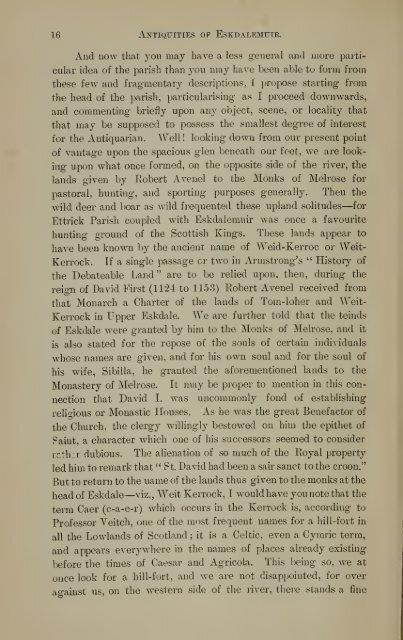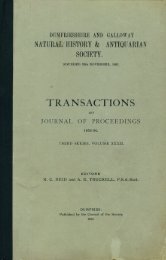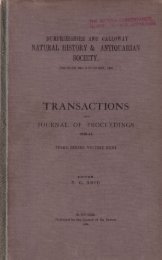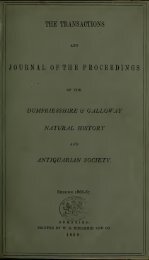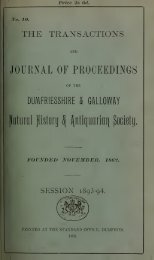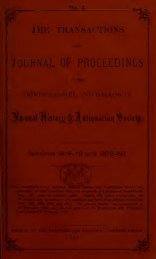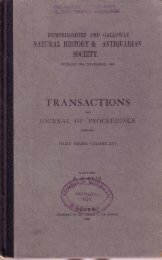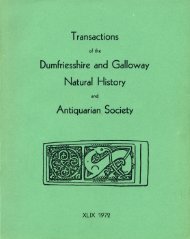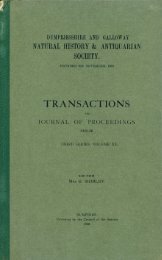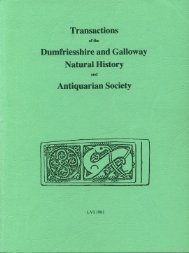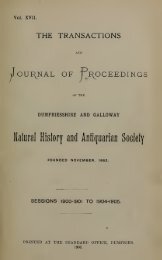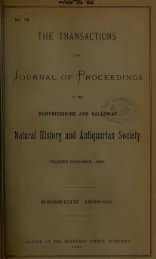Vol 13 - Dumfriesshire & Galloway Natural History and Antiquarian ...
Vol 13 - Dumfriesshire & Galloway Natural History and Antiquarian ...
Vol 13 - Dumfriesshire & Galloway Natural History and Antiquarian ...
You also want an ePaper? Increase the reach of your titles
YUMPU automatically turns print PDFs into web optimized ePapers that Google loves.
16<br />
Antiquities of Eskdalemuir.<br />
And now that you may have a less general <strong>and</strong> more parti-<br />
cular idea of the parish than you may have been able to form from<br />
these few <strong>and</strong> fragmentary descriptions, I propose starting from<br />
the head of the parish, particularising as I proceed downwards,<br />
<strong>and</strong> commenting briefly upon any object, scene, or locality that<br />
that may be supposed to possess the smallest degree of interest<br />
for the <strong>Antiquarian</strong>. Well ! looking down from our present point<br />
of vantage upon the spacious glen beneath our feet, we are look-<br />
ing upon what once formed, on the opposite side of the river, the<br />
l<strong>and</strong>s given by Robert Avenel to the Monks of Melrose for<br />
pastoral, hunting, ajid sporting purposes generally. Then the<br />
wild deer <strong>and</strong> boar as wild frequented these upl<strong>and</strong> solitudes—for<br />
Ettrick Parish coupled with Eskdalemuir was once a favourite<br />
hunting ground of the Scottish Kings. These l<strong>and</strong>s appear to<br />
have been known by the ancient name of Weid-Kerroc or Weit-<br />
Kerrock. If a single passage cr two in Armstrong's " <strong>History</strong> of<br />
the Debateable L<strong>and</strong>" are to be relied upon, then, during the<br />
reign of David First (1124 to 1153) Robert Avenel received from<br />
that Monarch a Charter of the l<strong>and</strong>s of Tom-loher <strong>and</strong> 'Weit-<br />
Kerrock in Upper Eskdale. We are further told that the teinds<br />
of Eskdale were granted by him to the Monks of Melrose, <strong>and</strong> it<br />
is also stated for the repose of the souls of certain individuals<br />
whose names are given, <strong>and</strong> for his own soul <strong>and</strong> for the soul of<br />
his wife, Sibilla, he granted the aforementioned l<strong>and</strong>s to the<br />
Monastery of Melrose. It may be proper to mention in this con-<br />
nection that David I. was uncommonly fond of establishing<br />
relio-ious or Monastic Houses. As he was the great Benefactor of<br />
the Church, the clergy willingly bestowed on him the epithet of<br />
Faint, a character which one of his successors seemed to consider<br />
rr.thir dubious. The alienation of so much of the Royal property<br />
led him to remark that " St. David had been a sair sanct to the croon."<br />
But to return to the name of the l<strong>and</strong>s thus given to the monks at the<br />
head of Eskdale—viz., Weit Kerrock, I would have you note that the<br />
term Caer (c-a-e-r) which occurs in the Kerrock is, according to<br />
Professor Veitch, one of the most frequent names for a hill-fort in<br />
all the Lowl<strong>and</strong>s of Scotl<strong>and</strong> ; it is a Celtic, even a Cymric term,<br />
<strong>and</strong> appears everywhere in the names of places already existing<br />
before the times of Caesai- <strong>and</strong> Agricola. This being so, we at<br />
once look for a hill-fort, <strong>and</strong> we are not disappointed, for over<br />
ao-ainst us, on the western side of the river, tliere .st<strong>and</strong>s a fine


